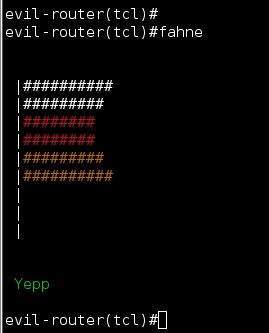| ANSI Color Output |
|
If you try to generate ansi escape sequences, you can use "term intern" on exec level For example, to clear the screen and display red heading text, use the following commands: exec terminal international; puts "\033\[2 Other Example:
proc fahne { } {
exec "terminal international"
puts "\033\[2J"
puts "\033\[0;0H"
puts "\033\[0m |##########"
puts "\033\[0m |#########"
puts "\033\[0m |\033\[31m########"
puts "\033\[0m |\033\[31m########"
puts "\033\[0m |\033\[33m#########"
puts "\033\[0m |\033\[33m##########"
puts "\033\[0m |"
puts "\033\[0m |"
puts "\033\[0m |"
puts "\033\[0m\n\n\033\[32m Yepp \033\[0m"
}
fahne
Sample Output 
For example, to clear the screen and display red heading text, use the following commands: exec terminal international; puts "\033\[2J\033\[H\033\[1;31mHeader text\033\[m" |